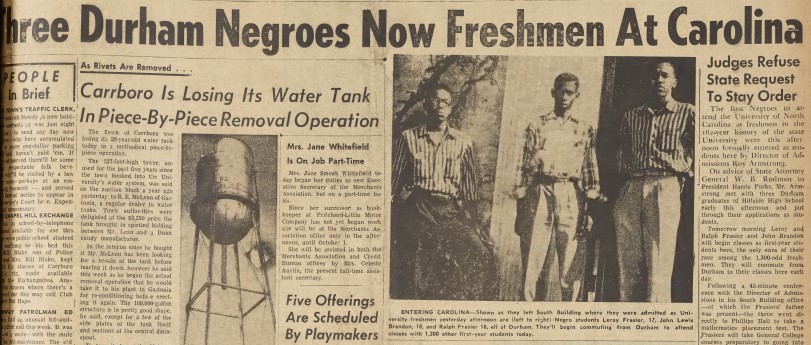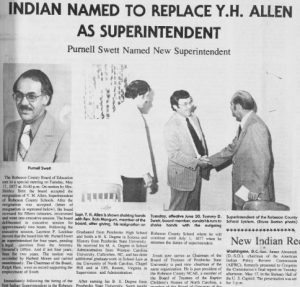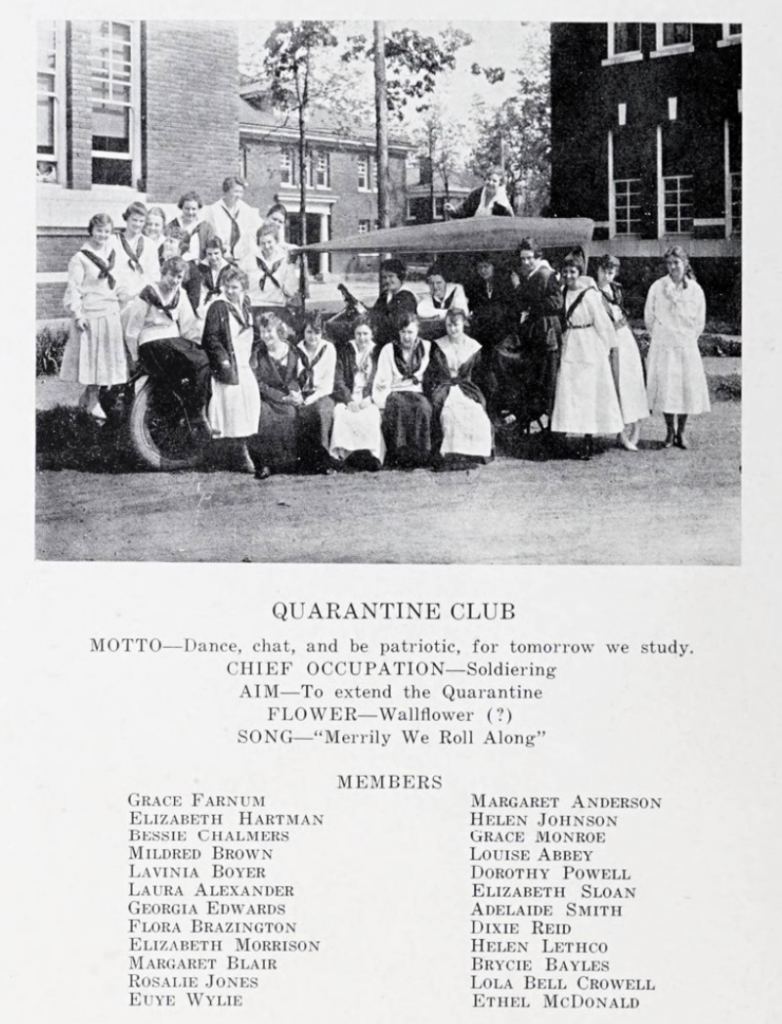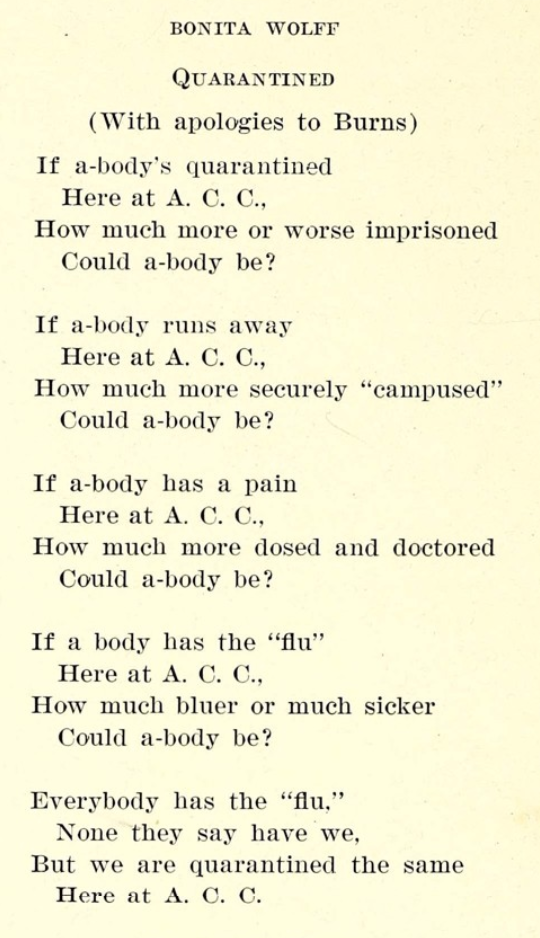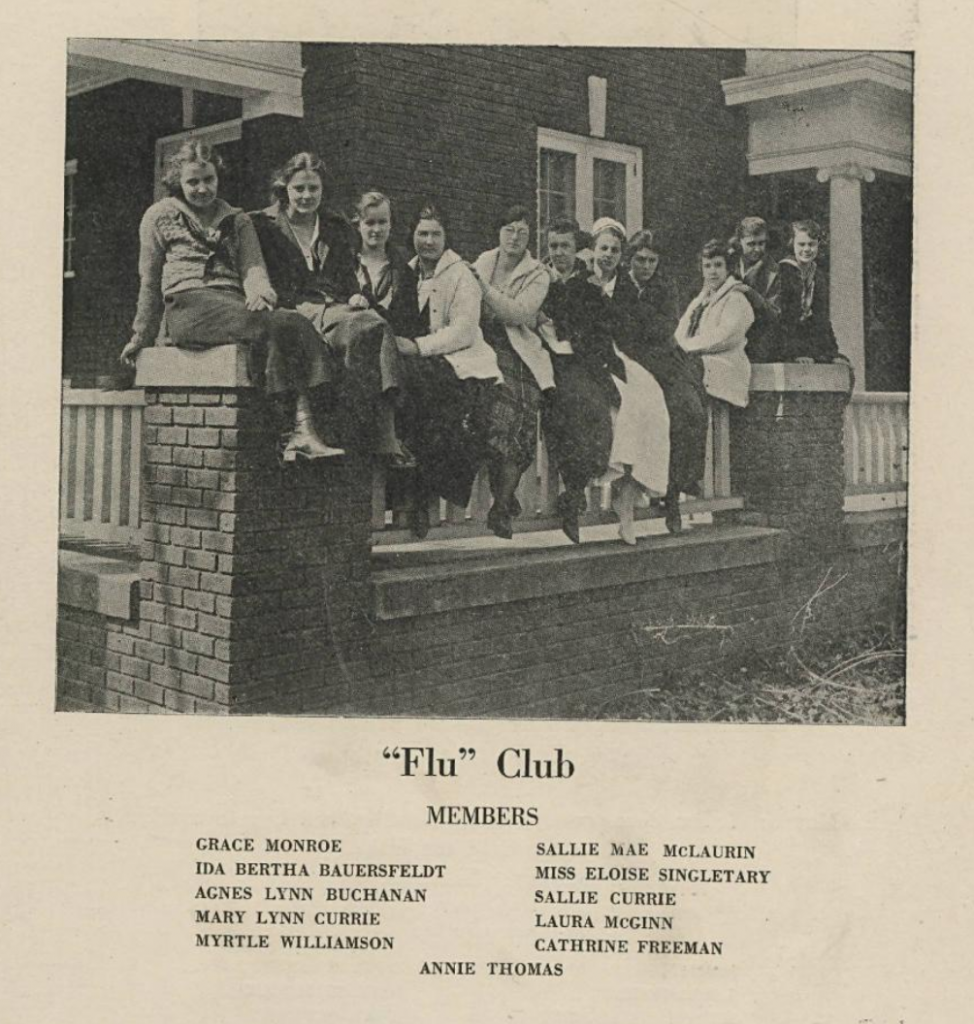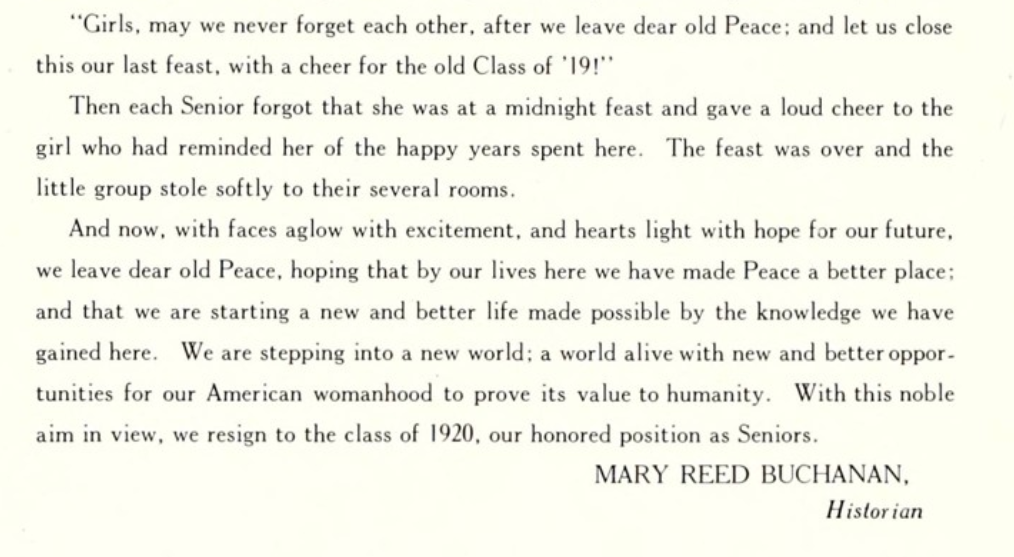Viewing search results for "University of North Carolina at Chapel Hill"
View All Posts
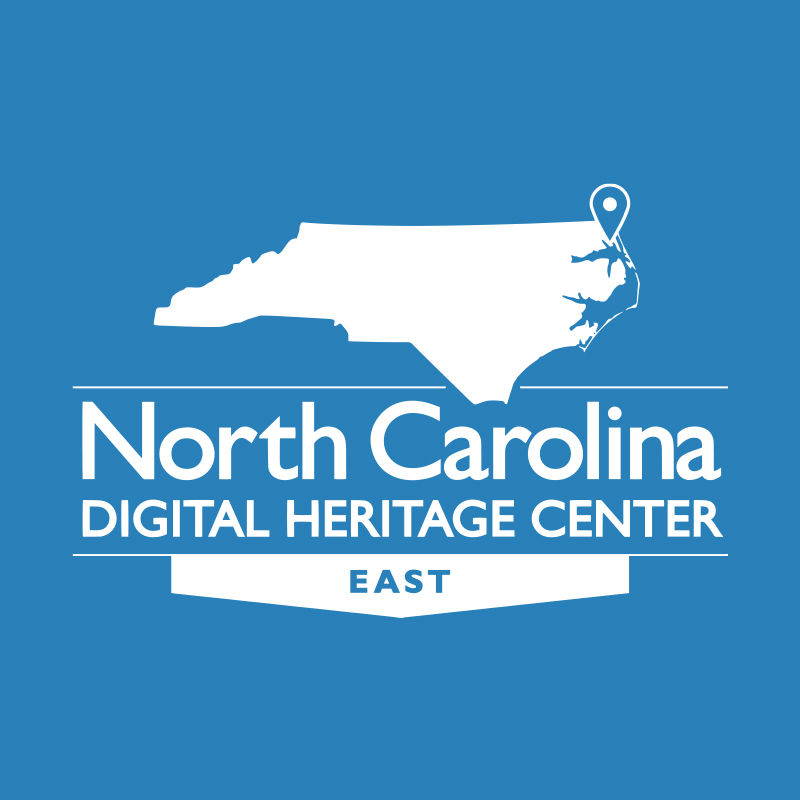 Since 1751, North Carolina newspapers have been one of the most valuable resources for researching our state’s history. They are also one of the most prolific, and demand for newspaper digitization is an area where we struggle even making a dent.
Since 1751, North Carolina newspapers have been one of the most valuable resources for researching our state’s history. They are also one of the most prolific, and demand for newspaper digitization is an area where we struggle even making a dent.
Thanks to funding from the State Library of North Carolina and a new partnership with G. R. Little Library at Elizabeth City State University, that dent just got a little bigger. ECSU is now home to our first satellite location, and the staff there are focused on print newspaper digitization.
In addition to meeting demand, setting up a satellite location in the eastern part of the state will diminish travel time for eastern partners interested in getting papers from their collections online. All materials will be scanned on a new large format scanner by the digitization technicians at ECSU. Then, after the images have metadata, they’ll be sent to Chapel Hill where they’ll be uploaded to the newspaper site on our page.
Our ECSU colleagues are currently working on papers from Northampton and Bertie counties. We’ll be working with our easternmost partners for more materials to scan in the coming months.
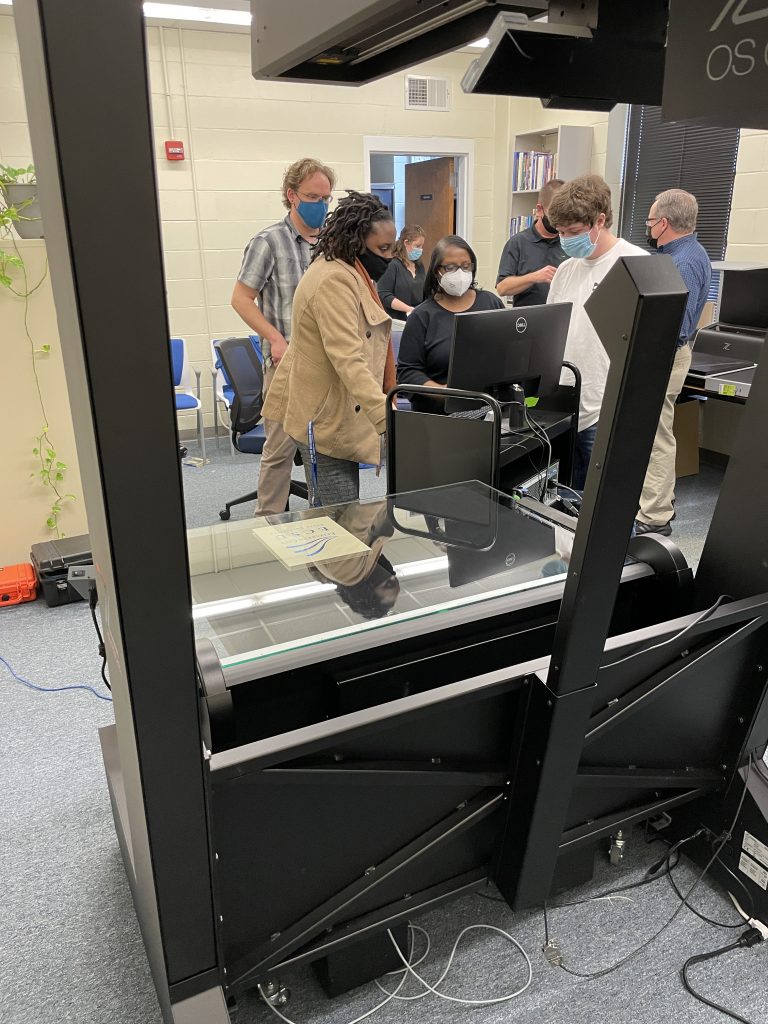
Zaina Goggins, Vicky Tillett, and Barry Ward work with a new scanner at ECSU Libraries.
Thanks to funding from an IDEA grant from UNC Libraries, the North Carolina Digital Heritage Center is pleased to now have the full run of 1951 issues of the Carolina Times digitized. The issues from 1951 were never microfilmed, so they were not included in previous projects to digitize the newspaper which were done from film.
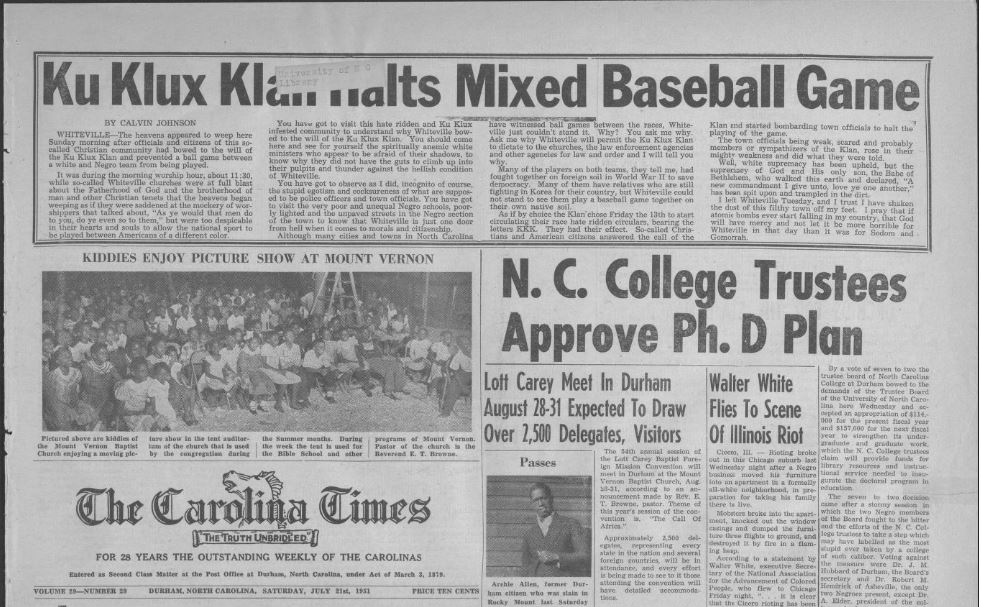
The Carolina Times, edited by Louis Austin from 1927 to 1971, was a paper of national significance. Targeted primarily to the African American community in Durham, the Times covered the long struggle for equal rights for all Americans. The newspaper’s motto was “The Truth Unbridled,” an accurate description of Austin’s honest and forthright depiction of racial injustice in North Carolina and beyond. It ceased publication in 2020, after just over a century of being the voice of the African American community in Durham and the wider state and South.
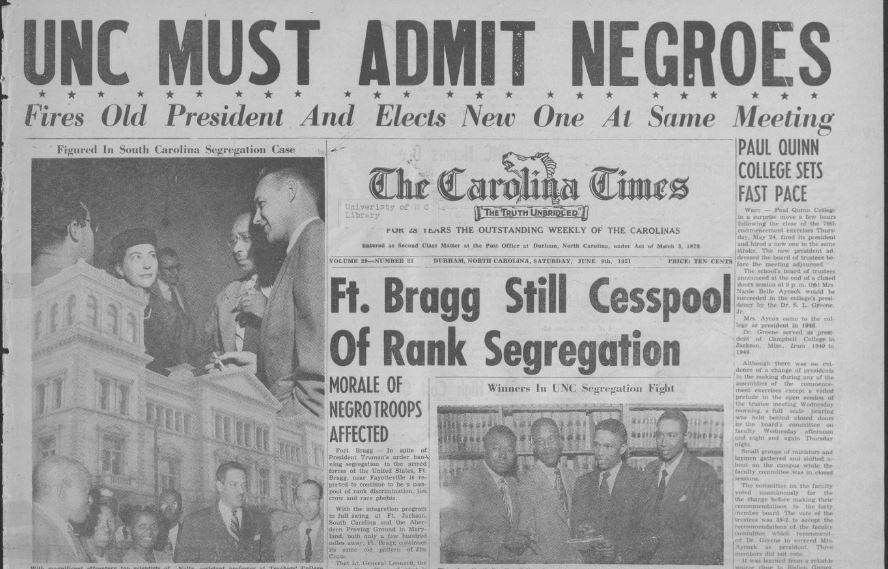
1951 was an pivotal year in many ways for the Civil Rights movement. It was in June 1951 that UNC finally allowed Black students admission to the school, with admission of Harvey Beech, J. Kenneth Lee, and Floyd McKissick into the law school. Headlines from the paper throughout the year speak to other efforts to integrate other institutions of higher education, the fight for better funding for Black educational institutions, and early efforts at integration of primary education institutions. Other topics, including the presence of the Ku Klux Klan across North Carolina and the violence of white supremacy, Jim Crow’s impact on all aspects of Black life, and the work of so many Black North Carolinians to fight the system are all covered throughout the year. Regular columns on education, religion, and other topics are also included in the paper, as well as Society pages, and regular news about the children of Durham that shows the moments of Black joy to be found in the community as well.
To view more Black newspapers on DigitalNC, visit our African American Newspapers exhibit. To learn more about the IDEA grant that funds diversity, equity, and inclusion work at UNC Libraries, visit here.
Thanks to our partners at the Chapel Hill Historical Society, DigitalNC is now home to 167 issues of the Chapel Hill News Leader. This batch includes issues from May 20, 1954 to December 29, 1955.
Covering stories in and around Chapel Hill and Carrboro, NC, the Chapel Hill News Leader frequently spoke on events at the University of North Carolina, Chapel Hill. In 1954, the U.S. Supreme Court outlawed racial segregation in public schools and in 1955 federal courts ordered the admission of Black undergraduates to UNC. The Chapel Hill News Leader, leading with a now famous photo, noted the admission of Leroy Frasier, John Lewis Brandon, and Ralph Frasier, the first Black undergraduate students at UNC, on their first day of school, September 15, 1955.
To view all issues of the Chapel Hill News Leader, click here. To learn more about the Chapel Hill Historical Society, please visit their website here.
DigitalNC is happy to announce a new batch of digitized newspaper issues from The Carolina Indian Voice. This round of issues includes most of 1976, all of 1977, and fill-ins for the years 1979-1996. These additions have brought us that much closer to a complete online collection of The Voice. We would like to thank our partners at the University of North Carolina at Chapel Hill for providing the physical issues that made this possible.
Established in 1973 and running until 2005, The Carolina Indian Voice published weekly on Thursdays. The Voice was based out of Pembroke, North Carolina, seat of the Lumbee Tribe of North Carolina. As the majority of Pembroke and Robeson County residents are of Lumbee ancestry, The Voice focused on local issues and events that spoke to the interests of the Indigenous community. With taglines such as “Dedicated to the Best in All of Us” and “Building Communicative Bridges in a Tri-Racial Setting”, many articles from ’76 and ’77 focus on advocacy and race. Headlines include local election coverage and racially conscious endorsements for representatives as well as pointed opinion pieces from founder and editor Bruce Barton on topics such as racial injustice.

The Carolina Indian Voice, August 12, 1976. This advertisement implores citizens to vote for representatives according to the population’s demographics for the Robeson County School District Board of Education election to correct long standing racial injustices; “six (6) Indians, two (2) Blacks, and one (1) White”.
The Carolina Indian Voice provides a necessary Indigenous perspective to life in North Carolina. To browse through all currently digitized issues of The Voice, click here. And to see more materials from our partner the University of North Carolina at Chapel Hill, visit their partner page here.
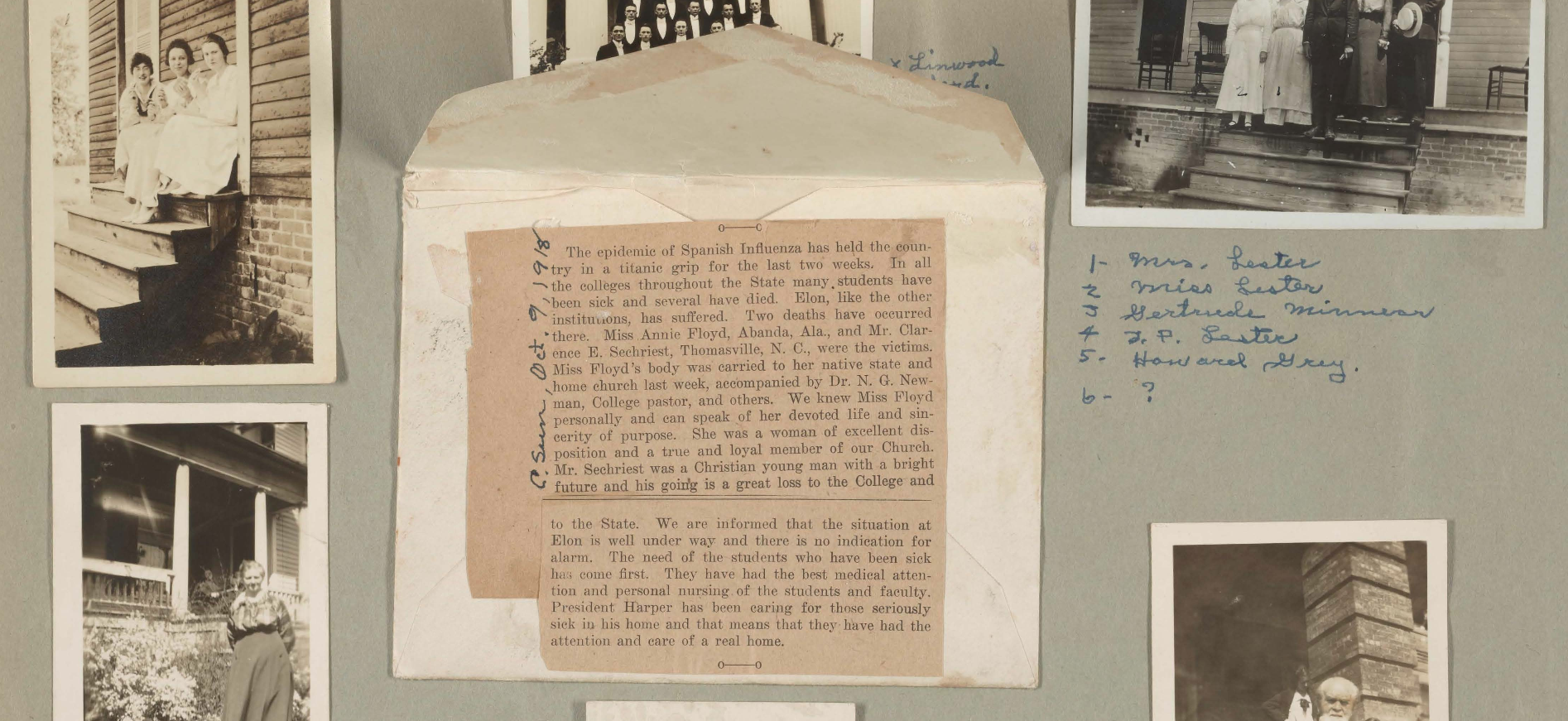
Page 31 of Annie Gordon Floyd’s scrapbook, a student at Elon College during the influenza pandemic of 1918. The newspaper clipping is Annie’s obitual; she died of influenza.
Here at the University of North Carolina, Chapel Hill, as well as across the globe, graduating students are leaving their school years behind without the normal pomp and circumstance. After years of late-night study sessions and racing to beat the assignment submission clock on Sakai, who would have thought that a pandemic would get between them and their walk across the commencement stage? While achieving a degree is a reason to celebrate regardless of location, perhaps 2020 graduates and all self-isolating students can relate to the experiences of an older group of students- those affected by the 1918 influenza pandemic.
Cutting through the spring of 1918 to 1919, the influenza pandemic was a worldwide health issue not unlike today. In North Carolina, industries were halted and quarantine was enacted (and extended). Universities, too, established their own versions of quarantine. Thanks to the institutions we work with here at DigitalNC, we have digitized yearbooks, scrapbooks, and college publications that offer a glimpse into the thoughts of students during this equally tumultuous time in history.
Quarantine was enacted in fits and spurts on campuses across North Carolina between 1918 and 1920. As is evident by yearbook social calendars, measures varied across universities. One campus quarantined through most of November 1918 while others were still starting up quarantine periods in February and March 1920.
Campus clubs have a dedicated slice of yearbook real estate during this time and the influenza directly impacted their activities. As the pandemic coincided with the last days of World War I, Student Army Training Corps (S.A.T.C.) were a part of many universities. The S.A.T.C. at Meredith College recounts their quarantine movements that saved faculty and students from “nervous prostration”. UNC’s S.A.T.C. found the flu less inspiring. Other students responded by creating clubs. At Queens College, Quarantine Club, seen left, first began in 1918 with the aim “to extend the quarantine”. Later, in 1920, the club edited their name to simply “Flu” Club, as seen below.
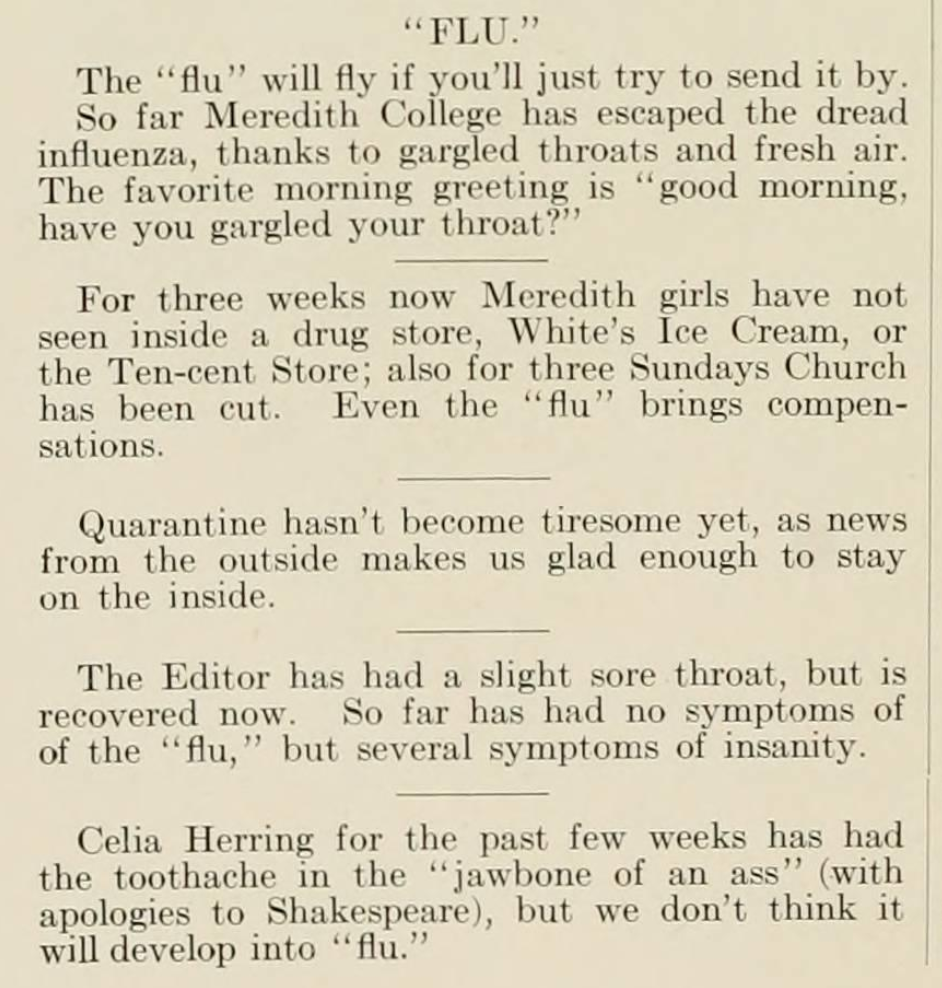
“Flu” section of the Meredith News and Distributor by French Haynes, Oak Leaves, 1919.
Students also utilized their yearbooks to creatively vent frustrations. In 1918, Atlantic Christian College students were under quarantine from February 6th to the 27th. Student Bonita Wolff penned several poems for The Radiant, including “Quarantined”, shown above. Another funny quarantine themed poem can be found in the advertisement section of the 1920 edition of St. Mary’s Muse.
Meredith College graduate French Haynes embedded influenza jokes throughout the satirical Meredith News and Distributor, shown to the right. And in 1920, Elizabeth Gaskins spotted a deficiency in her local health care system, due in part to the influenza, and argued for the creation of a local hospital in the Greenville High School yearbook The Tau.
If anything, these yearbooks serve as a reminder that this moment is not permanent. Comparing pandemics may be apples to oranges, especially when one student called quarantine “an awful bore” in a college that was only under quarantine for a month at a time, but Mary Reed Buchanan, member of the 1919 graduating class of the women’s college Peace Institute, offers some perspective in the senior class history:
With the warm spring came the renewal of all our former pleasures. There were parties galore, and girls, will you ever forget those State College receptions? And do you remember those exciting basketball games and the serenades afterwards? The feeling of being well again and out of quarantine brightened every heart and lightened every burden.
Even though we may not be attending basketball games anytime soon, we can look to those who have gone through a pandemic before and know that life, including student life, continues on. And for those who are graduating, Mary Reed Buchanan, noted suffragette, has final words:
For a look at all of DigitalNCs college and high school yearbooks, click here. Or, to view all memorabilia including scrapbooks, click here.
About two years ago, we had the honor of hosting a group of students from Wilmington who were studying one of the most politically and socially devastating moments in the state’s history–the Wilmington Coup and Race Riots of 1898. Their efforts centered around locating and studying the remaining issues of the newspaper at the center of that event, the Wilmington Daily Record. Owned and operated by African Americans, this successful paper incited racists who were already upset with the political power held by African Americans and supporters of equality. During the Coup, the Record’s offices were burned and many were killed. Thanks to these students, their mentors, and cultural heritage institutions, you can now see the seven known remaining issues of the Daily Record on DigitalNC.
Our main contact on this project has been John Jeremiah Sullivan, a well known North Carolina author and editor. He originally approached us back in 2017 to enlist our help and, since then, has been working with a cohort of supporters, volunteers, and students to dig deeper into the Daily Record and to raise further awareness of its history. Today we’re excited to share the Project’s latest efforts in Sullivan’s own words below.
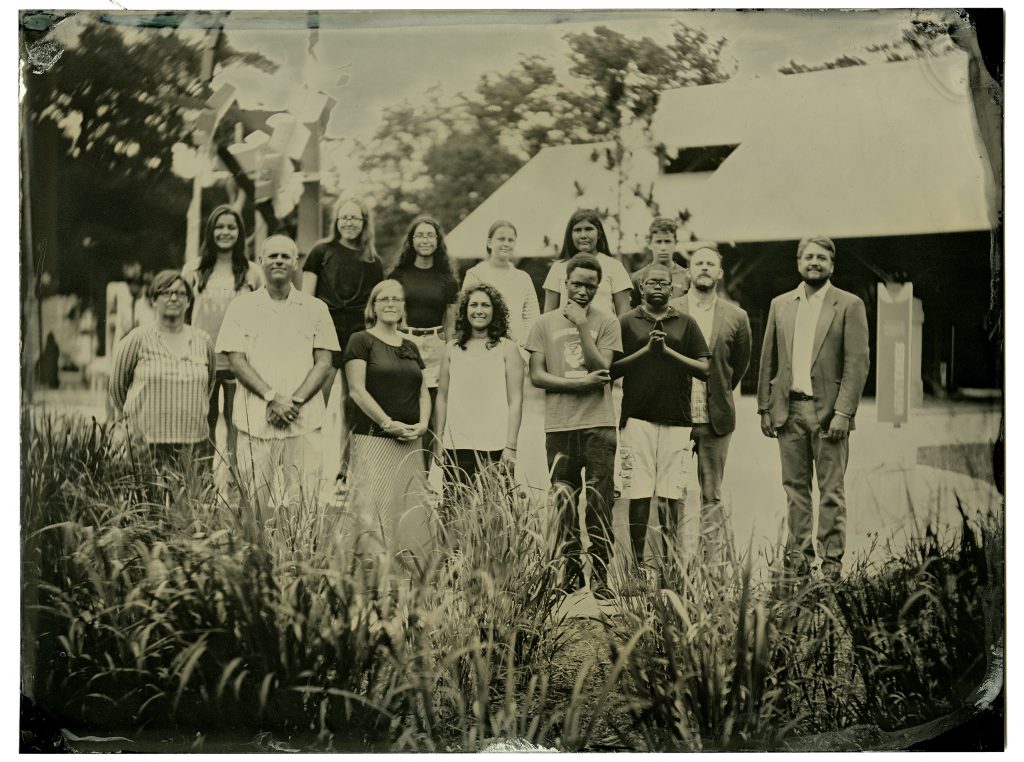
Daily Record Project Historians, taken by Harry Taylor in May 2017 at the Cape Fear Museum
Highlights
- Over the past few years, Wilmington middle school students have been combing through newspapers, periodicals, manuscripts, and other publications contemporaneous with The Daily Record searching for content from the Record that is quoted in those sources.
- Their efforts yielded numerous quotes, which have been assembled into what they’re calling a “Remnants” issue of the Record.
- Literary content, biographical information about the Record’s editors, Wilmington political news and more can be found in this issue.
- For the first time in one place you can read content that was published in issues of the Record that may no longer exist.
The Daily Record Project
by John Jeremiah Sullivan
“For the past four years, Joel Finsel and I, in conjunction with the Third Person Project, have been meeting weekly with groups of Wilmington 8th-graders to learn as much as we can about the Wilmington Daily Record, the African American newspaper destroyed at the start of the race massacre and coup d’état that turned Wilmington upside down in November of 1898. At the heart of the original Daily Record Project was an attempt to locate any surviving copies of the paper. Books and essays about the massacre always include a sentence along the lines of, ‘Sadly no copies remain,’ but it seemed impossible that they could all have disappeared. After three years’ hunting, we were able to identify seven copies–three in Wilmington, at the Cape Fear Museum (the staff historian there reached out to make us aware of their existence), three at the Schomburg Center for Research in Black Culture in New York City, and one at the State Archives of North Carolina in Raleigh. (The latter is a mostly illegible copy of the issue containing Alex Manly’s editorial of August 18, 1898, the article seized on by white supremacists as a pretext for stirring up race-hatred in the months before the massacre.) These seven copies, thanks to the North Carolina Digital Heritage Center, can now be examined online by anyone with an Internet connection. For the first time in more than a hundred years, it is possible to read one of the most famous and important African American newspapers of the late-nineteenth century.
“When those seven copies had been thoroughly read through and annotated, and it did not seem that any more were going to surface (at least not in the near future), we found ourselves faced with the question of “What next?” Should we discontinue the project? We had no desire to do that—it had been too much fun and we were learning too much. We had developed rewarding relationships with the three middle schools that sent their students to study with us: Williston School, D.C. Virgo Preparatory Academy, and the Friends School of Wilmington. The Daily Record Project had become a kind of field laboratory for excavating more information about the events of 1898 and Wilmington history more largely. The last thing we wanted was to shut that down.
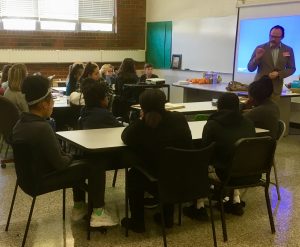
John Jeremiah Sullivan addressing the Daily Record Project class at DC Virgo Preparatory Academy, 2019
“We had noticed, in the course of studying the seven copies, that there did exist, in various sources from that period, isolated fragments of text from various issues of the Record that may no longer exist. We were finding these fragments in other newspapers. Just as publications do today, papers were reprinting one another’s material. Sometimes it was in the form of a quotation—several paragraphs, or even just a sentence. Sometimes whole articles were being re-published. In a couple of cases, the text survived by way of advertisement: a traveling circus, for instance, had liked what the Record said about it when it passed through Wilmington, and used that paragraph in announcing future appearances. We started wondering how many of these “ghost” stories might exist. The more we looked, the more we found. We enlisted the 8th graders to help us search. They turned up even more stuff. The range of sources we were using expanded. From old newspapers we moved on to magazines and books and pamphlets and letters. Often the writers or editors doing the quoting were critical of, or even hostile to, the Record and its politics. In attacking pieces from the Record that had offended them, they were unwittingly preserving more of that newspaper’s copy for future generations.
“By the time it was over, we had a folder containing scores of these “remnants,” as we were calling them, enough to create an entire new issue–a “ghost issue”–of the Daily Record, and that is what we have done.
“To create the actual issue, we worked with a brilliant graphic designer in New York named Stacey Clarkson James, who for many years had been the Art Director at Harper’s Magazine. I had worked with Stacey at Harper’s many years ago and have collaborated with her many times since. She exceeded even our high expectations by designing a newspaper issue that is not so much an imitation of the original Daily Record as a resurrection. She went in and crafted, by hand, a typeface that matches the now-extinct one used by Alexander Manly and the original editors. Then she laid out the pages according to the old 1890s press-style, even dropping in advertisements that we knew to have appeared in the Record. At the top it says REMNANTS. We gasped when we saw it.
“On the second page, above the masthead, can be seen a list of sources we used. There are a lot of them. The very size and range of the list shows the scope of the Record’s notoriety in its day. It was being read in many parts of the country.
“Maybe the most interesting thing about this issue is that, because it consists only of material that other publications found interesting enough to re-print, it winds up forming a kind of Greatest Hits compilation (though all of these “hits” have been buried in other papers until now). It’s a fascinating issue to read. There are articles on politics, culture, and social life, as well as strange unplaceable pieces, like the one about a man in Arkansas who caught fire in his orchard and just kept burning. No one could put him out. We still aren’t sure what that one means.
“Two of many things worth highlighting within the “Remnants” issue:
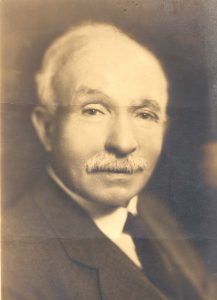
Charles W. Chesnutt, Charles Chesnutt Collection, Fayetteville State University Library.
“First–at the center of the issue is Charles Chesnutt’s short story, “The Wife of His Youth.” Chesnutt was, of course, one of the first great African-American fiction writers, and the novel that many consider to be his greatest work, The Marrow of Tradition, is a re-telling of the events of 1898, set in a fictionalized Wilmington that he calls Wellington. Chesnutt had many and deep ties to this city, more than most scholars are aware. (His cousin, Tommy Chesnutt, was the “printer’s devil” or apprentice at the Daily Record–you can find his name on the masthead on page 2.) “The Wife of His Youth” is probably Chesnutt’s best-known story. What’s curious is how we learned that it ran in the Daily Record. In Chesnutt’s published correspondence, there is a letter to Walter Hines Page, his editor at the Atlantic Monthly. It’s basically a letter of complaint: Chesnutt is telling Page that Alex Manly had reprinted the story (serially) in the Record, without having asked permission. At the time of that writing the Record had already been burnt and Manly had fled Wilmington, so Chesnutt essentially says, I guess we can give him a pass… But the complaint contained valuable information, because it tells us that the Record had an ongoing literary dimension. Manly was likely running stories and poems quite frequently—one of the seven surviving copies also contains a short story, “The Gray Steer” by one Frank Oakling. It’s on page 3 of the August 30th, 1898 issue.
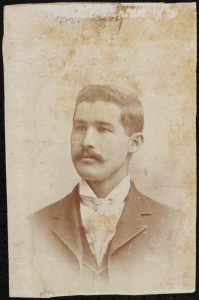
Alexander Manly, in the John Henry William Bonitz Papers #3865, Southern Historical Collection, The Wilson Library, University of North Carolina at Chapel Hill.
“Second–readers will notice that at the end of the “Remnants” issue, in the last couple of columns on the last page, there is a series of articles from not the Wilmington Daily Record but the *Washington* Daily Record. These represent probably the most exciting discovery we made during this most recent session of the Daily Record Project. The way the story of 1898 traditionally gets told, the massacre and coup d’état marked the end of the Manly brothers’ journalistic careers: they left the city, their ambition blighted, and sank into relative obscurity. The reality could not have been more different. It turns out that the Manlys went almost immediately to Washington, D.C., and re-established the Daily Record there. Before a year was out, they had the press up and running. They operated the Daily Record for four more years in the capital, then handed it off to another editor, who ran it for another six or seven. One of their articles included here is a stirring anti-imperialist denunciation of American military intervention in the Philippines. Another describes the renaissance in African-American literary activity that was felt to be happening around the turn of the century. As far as we can determine, these few pieces represent the only extant copy from the *Washington* Daily Record, for its entire decade-long run.
“There is much more worth unpacking, but we want to allow visitors to the NC Digital Heritage Center’s website to have the fun of doing that themselves.
“Long live the Daily Record. Thank you for reading.
“There are a lot of people to thank. First, the incredible 8th-grade students participated in the “Remnants” session of the Daily Record Project. It was a privilege to work with them and be around their energy:
- Ridley Edgerton
- Bella Erichsen
- Dymir Everett
- Love Fowler
- Malakhi Gordon
- Heaven Loftin
- Katy McCullough
- Juan Mckoy
- Shalee Newell
- Isis Peoples
- Nakitah Roberts
- Gabe Smith
- Maria Sullivan
- Latara Walker
- Ramya Warren
“Second, the adults (teachers, administrators, chaperones, donors, friends, and Third Person Project members) who contributed every week to making this year’s work possible:
- Rhonda Bellamy
- Dan Brawley
- Laura Butler
- Stacey Clarkson James
- Michelle Dykes
- Clyde Edgerton
- Brenda Esch
- Joe Finley
- Cameron Francisco
- Sabrina Hill-Black
- Mariana Johnson
- Trey Morehouse
- Tana Oliver
- Donyell Roseboro
- Elliot Smith
- Beverley Tetterton
- Larry Reni Thomas
- Candace Thompson
- Leyna Varnum
- Tony Ventimiglia
- Florence Weller
- The Cape Fear Museum
- NC State Archives
- The Schomburg Center
“And finally, a shout-out to the Digital Heritage Center. Thanks to you, more than 120 years after white supremacists tried to erase the Daily Record, people are reading it again.”
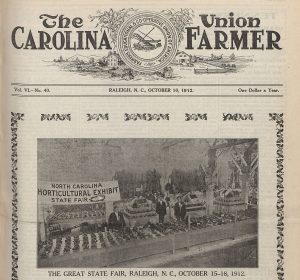
Front page of the Carolina Union Farmer, October 10, 1912
100 issues of the Carolina Union Farmer are now online at DigitalNC. The recently digitized issues form a nearly complete representation of the weekly paper’s publication between July 1911 and May 1913. Published by the North Carolina Farmer’s Union, the paper provides unique insights into the Labor Movement as it manifested itself in the South during the early twentieth century.
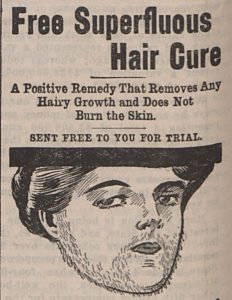
Cosmetics ad in the August 22, 1912 issue
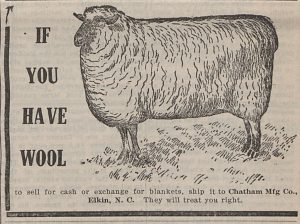
Wool-buyers ad in the August 14, 1912 issue
The issues deal heavily with economics, politics, religion, and topics of agrarian interest, all seen through a distinctly Progressive-Era lens. Many articles urge their audiences to organize against large corporate farming interests and provide instruction as to how the average farmer might go about doing so. Also included are pages of classified and commercial ads, op-eds, cultural submissions such as poetry and prose, and notifications for events and programs hosted by the Farmer’s Union. Many of the issues published in the second half of 1912 feature columns related to the 1912 national and state elections, with political advertisements and endorsements occupying several pages.
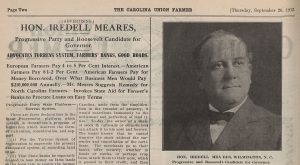
Political ad in the September 26, 1912 issue
These issues of The Carolina Union Farmer are held by UNC Libraries. Click here to learn more about the other UNC materials hosted online at DigitalNC.
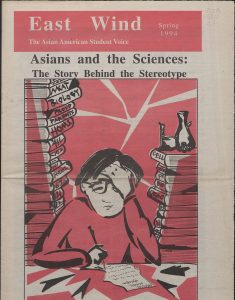
Front page of the Fall 1994 issue of UNC ASA’s East Wind newspaper
Seven issues of East Wind, a publication of UNC Chapel Hill‘s Asian Students Association, are now available online at DigitalNC. Started in 1993, the paper appeared roughly once a semester for the first several years of its run. The issues now on DigitalNC (December 1993-Spring 1998) cover a wide range of topics relevant to the Asian-American student community at UNC. With its editorials, advertisements for upcoming events, restaurant reviews, and much more, East Wind provides a forum for both ASA members and others to promote, criticize, and discuss Asian-American culture from numerous angles. Much of the paper’s contents focus on issues of race and identity within the Asian-American community.
The newly digitized issues of East Wind are another addition to the already considerable amount of UNC Chapel Hill materials currently hosted at DigitalNC. For more information about East Wind and the Asian Students Association at UNC, visit The Carolina Story and its exhibit on UNC student organizations.
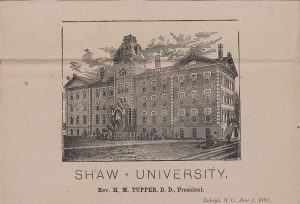
Image from a Shaw University admissions flier, 1892
A new batch of materials documenting the history of Shaw University, a historically Black liberal arts institution in Raleigh, NC, are now online and available for use at DigitalNC. The materials consist of commencement programs, annual reports, and an admissions flier from the 1890s and early 1900s as well as a program for a missionary training conference held at Shaw University in 1946. The earlier set of documents provides insights into the recruitment efforts, budgetary concerns, and graduation ceremonies of the university. Similarly, the 1946 program documents the results of a teaching partnership between the university and the General Baptist State Convention of North Carolina.
The materials are currently held by UNC Libraries. To learn more, visit UNC’s partner page or Shaw University’s website.
We are one of 29 finalists for the Institute of Museum and Library Services 2018 National Medal for Museum and Library Service. Now through April 13, IMLS is asking the people who have been impacted by the Digital Heritage Center to share their stories. If you have a story you’d like to share, we’d love to hear from you! Please contact us or share via social media by tagging us on Facebook (@NC Digital Heritage Center) or on Twitter (@ncdhc).
Today’s story comes from Professor Robert C. Allen, Professor in the Department of American Studies at UNC-Chapel Hill and faculty lead of the Community Histories Workshop. Dr. Allen shared the thoughts below in support of our Medal application and we reshare them today with his permission.
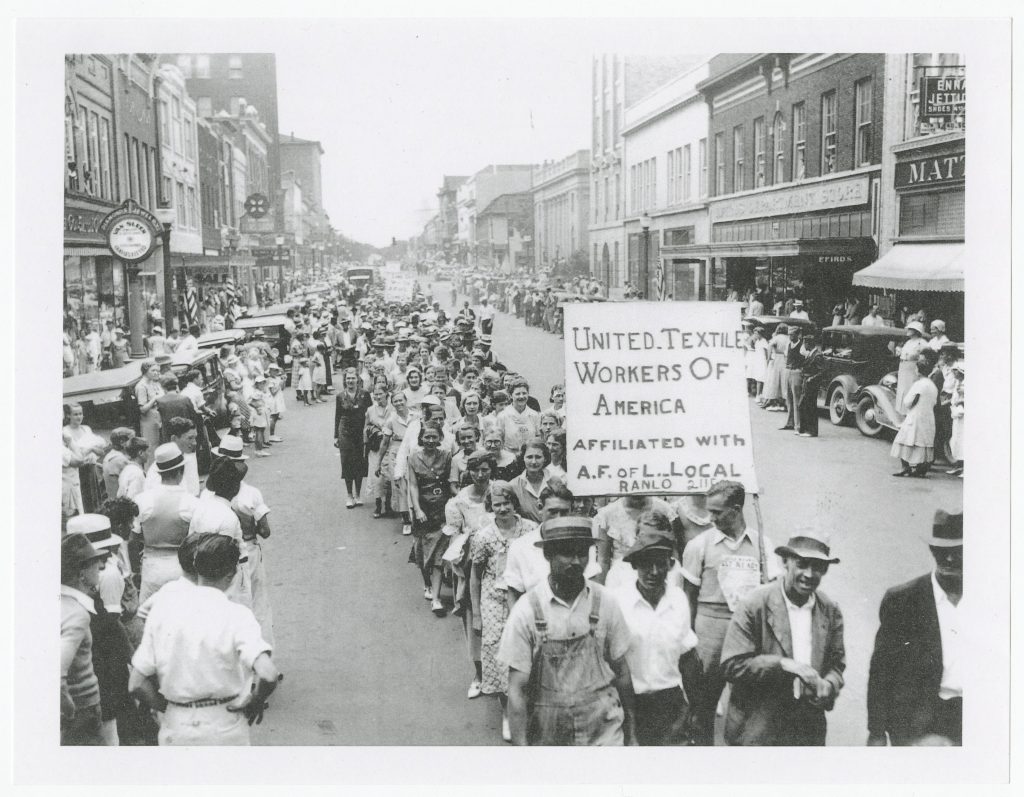
Textile Workers Marching in Gastonia, NC, 1929. From the Gaston County Museum of Art & History
“Since 2013, I have been working closely with the N.C. Digital Heritage Center on ‘Digital Loray,’ the most ambitious public humanities program ever undertaken by UNC. This project uses the adaptive reuse of an iconic industrial structure—in this case, Gastonia’s Loray Mill, one of the largest cotton mills built in the state—as a catalyst for a long-term community history and archiving initiative. The ‘heart of this open-ended project is an archive of more than 2500 digital objects, brought together in a single interface from the UNC North Carolina Collection and other Wilson Library collections, other institutional archives, community cultural heritage organizations, churches, and individual community contributors.
“The NC Digital Heritage Center was absolutely instrumental in our ability to undertake this kind of deeply collaborative community history work. It worked with the Gaston County Museum of Art and History—the primary cultural heritage organization in the county—to identify, digitize, and publish material from its collection that could be ‘added’ to Digital Loray. Three community members had saved many documents, photographs, maps, mementos, and other material from the mill at the time of its closing in 1993. Working with the N.C. Digital Heritage Center, we encouraged them to donate this material to the Gaston County Museum of Art and History, which, in turn, allowed the center to facilitate the digitization and publication of these unique artifacts…
“In short, I could not extend my teaching, graduate training, and the work of my unit into communities in North Carolina without the invaluable assistance of the N.C. Digital Heritage Center. But I am not the most important beneficiary of its effectiveness and leadership: it enables hundreds of small museums, public libraries, historical societies, and other cultural heritage organizations to add a digital dimension to their work and, in doing so, to preserve and share the histories of their communities. These perennially threatened local organizations can undertake what otherwise would be impossibly expensive and technically complex digitization projects without the need for technical specialists or third-party software and hosting solutions.
“The N.C. Digital Heritage Center should be a model for other states. It deserves much more attention on a national level than it has received, particularly in the realms of public history, digital history, public humanities, and digital humanities. I have reviewed and attended presentations about ‘sexier’ and much better resourced projects over the past few years, but none I think has had a greater or longer-lasting impact than the quiet but profoundly important work of my colleagues in the N.C. Digital Heritage Center. I congratulate them and thank them for all they do to make my university a great resource for the people of North Carolina.
 Since 1751, North Carolina newspapers have been one of the most valuable resources for researching our state’s history. They are also one of the most prolific, and demand for newspaper digitization is an area where we struggle even making a dent.
Since 1751, North Carolina newspapers have been one of the most valuable resources for researching our state’s history. They are also one of the most prolific, and demand for newspaper digitization is an area where we struggle even making a dent.



